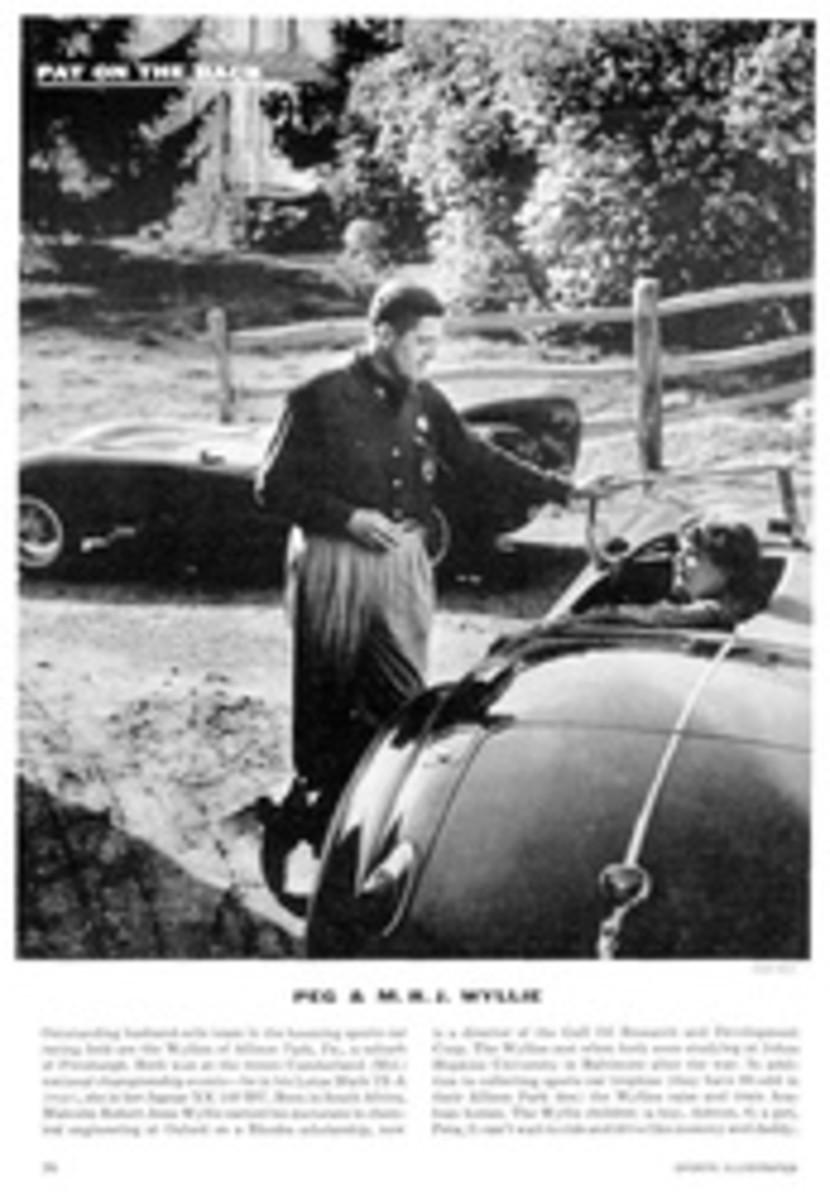
THE OUTDOOR WEEK
Based on regular weekly dispatches from SI bureaus and special correspondents in the U.S., Canada, Mexico and overseas; and on reports from fish and game commissions of the 48 states and Alaska
CONSERVATION COMMISSIONER WEHLE HURLS LURID CHARGES AND FACES INQUIRY
A fortnight ago Louis Aloysius Wehle, an affable 66-year-old beer baron who dabbles in the intricacies of modern wildlife management, capped 18 bizarre months as New York Conservation Commissioner with a speech that goaded his already battle-weary department into open rebellion and evoked such anguished howls of lay as well as official indignation that Governor Averell Harriman has had to concede the embarrassing necessity for a public inquiry into his own appointee's charges.
If he stays in office through the hearings, Commissioner Wehle may find his administration of New York conservation attacked on a number of counts as something less than enlightened, but the immediate cause of Harriman's drastic action was the petulantly brutal accusation from Mr. Wehle that a "secret fraternity" in the Department of Conservation, through "gross negligence" or "deliberate sabotage," had torpedoed his pet project to toughen hatchery pheasants by rearing them in the wild. Of 20,000 young birds shipped to Lake Ontario's Grenadier Island, charged Wehle, 15,700 died, virtually all from botulism, and the man "100% to blame" was chief of the department's Game Bureau, Dr. E. L. Cheatum, who had deliberately authorized botulism infected birds included in the shipment. Wailed Wehle: "It was like sending kids with measles into a kindergarten full of unvaccinated children."
Within hours of the commissioner's unfortunate words he was caught with his facts miserably down and the national dander up. Almost without exception men and organizations prominent in American conservation activity, and many out of it, have made public their unqualified support of Dr. Cheatum. But the most scathing commentary on Mr. Wehle's action came from Pieter W. Fosburgh who, in 10 years as editor of The New York State Conservationist, guided that publication to a position of respect unique in its field. Wrote Fosburgh to the commissioner: "...By making such charges I believe you have struck a body blow at the morale of all of the rank and file of this department.... I do not think it advisable, or even possible, for me to continue to edit the department's magazine in the atmosphere of suspicion and distrust you have created. I am therefore resigning." Mr. Wehle accepted the resignation without comment.
Amid the hubbub, Dr. Cheatum's confident denial of the commissioner's accusations went relatively unnoticed, and he is reluctant to pursue the matter publicly. In fairness to Mr. Wehle, he told an SI correspondent, he will wait and present his case to the three conservationists selected by Governor Harriman to conduct hearings. That case, however, will be a strong one. Albany experts in veterinary medicine insist that precautions taken by Dr. Cheatum "strongly indicate" that birds shipped to Grenadier Island were not carrying botulism. They point out that this form of poisoning, far more deadly to man and animal than measles, is not communicable in the ordinary sense. The organism which causes the fatal disease is always prevalent in soil, but wildlife and humans can only contract it by eating contaminated food in which the botulism organism has grown and produced its toxin. Probably, the experts say, the Grenadier Island outbreak originated on the island itself.
Even if an honest mistake has been made, Commissioner Wehle is still on shaky ground. A confidential SI source maintains that the biologists' report on the Grenadier debacle will conclusively demonstrate that 1) far more birds died from predation, and other natural causes, than from botulism; 2) Mr. Wehle insisted on the project even after his staff technicians warned him that it was economically unsound, and that the island was far from ideal pheasant habitat and lay in the path of a major hawk migration route. (He could not, the commissioner had flatly said at one point, abide "Fauntleroy pheasant.")
Conservationists hope that if New York's unhappy situation does nothing else it will awaken nationwide recognition that conservation is a field for trained experts, not political appointees even as well-meaning as Wehle is conceded to be. They condemn what they regard as his stubborn insistence on carrying out ill-advised personal projects without or against the counsel of his career staff (OUTDOOR WEEK, May 28).
SI shares the natural and general sympathy for the independence of mind which the commissioner plainly does not lack in his lonely battle, but also most admires that quality when it is allied with fairness and old-fashioned common sense.
Simultaneously controversy raged in Washington. Conservationists, already distressed in 1953 when the top posts in the Fish and Wildlife Service were taken from civil servants and given to political appointees, are beside themselves over a recent White House order which by July 1 will take the fish out of Fish and Wildlife and create a new Bureau of Fisheries with strong emphasis on economically frustrated commercial fishing activities.
Last week nine conservation groups, representing the country's 40 million sportsmen, charged that the new bureau would not really help commercial fishermen whose woes mainly stem from high operating costs, overexploitation of fish resources and low tariffs on imported sea food. But, they emphasized, splitting the Fish and Wildlife Service will create severe liaison difficulties and relegate a sport fishery of vast economic and recreational import to a secondary position.
Assistant Secretary of the Interior Wesley A. D'Ewart says sportsmen are wrong in fearing that the reorganization will benefit commercial fishing at their expense. "We have been," he stated, "equally concerned with problems of recreational and commercial aspects of our fish resources." Spokesmen for commercial fishery interests also spoke soothingly, declaring they have no intention of forcing sport fishing into the background.
Outdoor Week will report further developments.
FISHERMAN'S CALENDAR
SO—season opened (or opens); SC—season closed (or closes).
C—clear water; D—water dirty or roily; M—water muddy.
N—water at normal height; SH—slightly high; H—high; VH—very high; L—low; R—rising; F—falling.
WT50—water temperature 50°.
FG—fishing good; FF—fishing fair; FP—fishing poor; OG—outlook good; OF—outlook fair; OP—outlook poor
TROUT: NEW YORK: Beaverkill and Willowemoc featuring spotty March Brown hatch and many small fish. Streams N and C but FF.
ONTARIO: FG as warm weather takes hold and streams drop. Lake shoals producing on wet flies and bait. Wendigo Lake yielding speckles to 3 pounds on bright dry fly variants; OG. Kamloops to 15 pounds spotted in Stoney Creek near Sundridge but are coy; OF.
MICHIGAN: All streams L and C with dry fly OVG. Main branch of Au Sable, Black River and Jordan River above Webster's Crossing surrendering fine catches. Lake Leelanau anglers still taking big browns and OG.
IDAHO: Lake Pend Oreille trollers snagging hefty Kamloops with Mrs. Mila Snow of Clearfield, Utah, boating a 21-pounder; OG. Most streams H and M but FF. French Creek off Salmon River hot with anglers limiting on spinners. North fork of Payette also tempting. Warm Springs Creek in Sun Valley good bet on number 6 Renegades. Statewide OG
MINNESOTA: Brown trout to 4 pounds hungry on Straight River at Park Rapids with water N and C and OG. Beaver dam pools of north shore streams reported FG for brookies.
PENNSYLVANIA: Gleeful central state spy advises trout have at last been caught in his sector and OG. Northern Tier streams L with mayfly hatches accelerating especially in Clinton County's Fishing Creek; OG. Pine Creek from Slate Run to Waterville rewarding wet fly practicioners with rainbows. Smallmouth bass SO June 15 in Lake Erie.
STRIPED BASS: RHODE ISLAND: Some big fish to 40 pounds reported in Charleston area. Warren River conditions bright for school fish on incoming tide. OVG generally.
MASSACHUSETTS: Cape Cod Canal casters connecting on plugs with local agent reporting a 49-pounder. First fish taken from Billingsgate Shoals in Cape Cod Bay last week on trolled eel skins and OVG in this hottest of all June spots. Flying correspondent radios that big fish are in surf off Orleans and beach buggy anglers are standing by for imminent bass blitz; OVG.
NEW JERSEY: Sandy Hook and Roamer Shoals area being worked round the clock by boatmen with catches of eight fish to 45 pounds common. Spoons and plugs by day, plugs and rigged eels by night, irresistible striper delicacies; OVG. Some surf results at Long Beach and rowboat fishermen at Rumson Bridge scoring at slack water with spinners and sand worms.
ATLANTIC SALMON: MAINE: Heavy run of fish entering Narraguagus River at Cherryfield where Dr. Nathan Fuller of Canton, Mass. killed a 14-pounder June 2 at Hackmatack Pool on a No. 2 Parmachenee Belle streamer. Water conditions ideal and OVG.
NOVA SCOTIA: Province catch totaled 145 fish last week with Medway, Lahave and St. Mary's rivers top spots; OG.
NEW BRUNSWICK: Backwoods dopester sends wire that fine run is on in main Miramichi; OVG.
TARPON: FLORIDA: Keys report finest fishing in 10 years; OVG. West coast mysteriously tapering off but OG. Most disappointed tarpon angler of week was Don Zimmer of Fort Myers who was fishing from a boat six miles off Estero Island when a barracuda bounced into the cockpit, munched on Zimmer's leg and bounced out again. Zimmer retired to Fort Myers' hospital for repairs.
TEXAS: Tarpon schools at all Gulf points with Port Isabel, Port Aransas, Galveston and Free-port all enjoying heavy runs. Fish also churning Brazos Rivert at Freeport. Padre Island pier perchers harvested 21 fish in one night, the largest a 7-foot one-incher; OVG.
BONEFISH: FLORIDA: Keys fishing topnotch. Mrs. Mary van Daalen of Naples, Fla. garnered 26 boners in three days on 8-pound test line and released them all; OVG.
MUSKELLUNGE: WISCONSIN: FF last week with arrival of hot weather. In Eagle River area William Casper of Lac Vieux Desert nailed a 42-pounder. Hopeful news received from Island Lake chain and Flambeau River in Rusk County. Mason Lake and Phillips Flowage in Price County OG. Spoons, bucktails and plugs favored lures as lake water levels lower; most areas OG.
MINNESOTA: 37-pounder captured in Cass Lake as Muskie action picks up. Leech Lake fish following lures but hits are scarce; OG.
WHITE MARLIN: NORTH CAROLINA: Billfish showing in Gulf Stream off Cape Hatteras as season's first, a 6-foot 8-incher, went to Al Ferguson of Washington, D.C. Fish are moving northward and OG.
TWO PHOTOS
TIRED ROBINS
Presumably faced with a housing problem this spring, two robins built their nest, now complete with eggs, in the rear of an oil truck operating out of Oshawa, Ontario and they insist on keeping Driver Keith Moffat company during his daily 261-mile stint. The birds may leave the truck to forage, explains Moffat, but they manage to catch up a mile or two down the road.
Fortunately, Oil Firm Owner Harry Perry is an understanding man. When the eggs hatch, the truck will stand in the company's yard until the fledgling robins can fend for themselves. "When they have gone to all this trouble..." said Perry, "we will certainly not interfere with their home."
FISH BOX
W. Rowell Chase of Cincinnati shows justifiable pride in the 128-pound tarpon he took on a fly rod off Islamorada in the Florida Keys. Chase used a 9-foot 6½-ounce glass rod and GAF line backed with 225 yards of 16-pound test nylon. The tarpon took a streamer and battled for 40 minutes.

